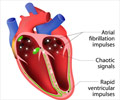Atrial fibrillation is one of the leading causes of abnormal heart rhythm and an old drug calked Flecainide is safe to treat this condition.

The condition is often asymptomatic but may result in palpitations, chest pains, congestive heart failure or clot formation with a risk of its migration to other parts of the body.
The long- term sustainable restoration of sinus rhythm (SR) has been well recognized with use of the drug Flecainide. However most doctors still avoid using the drug in treating these abnormal rhythm (or arrhythmia) and this has been due to the increased mortality attributed to this drug that was published in 1991 in a study called Cardiac Arrhythmia Suppression Trial (CAST)..
However the current research shows that it is safe to use this drug in AF provided the patient with AF has no left ventricular disease or coronary heart disease.
Avoiding the use of this useful drug denies the patients of an important treating alternative. Hence it is now suggested that Flecainide should be the first drug of choice to restore sinus rhythm in patients with atrial fibrillation
Reference:
Source-Medindia











